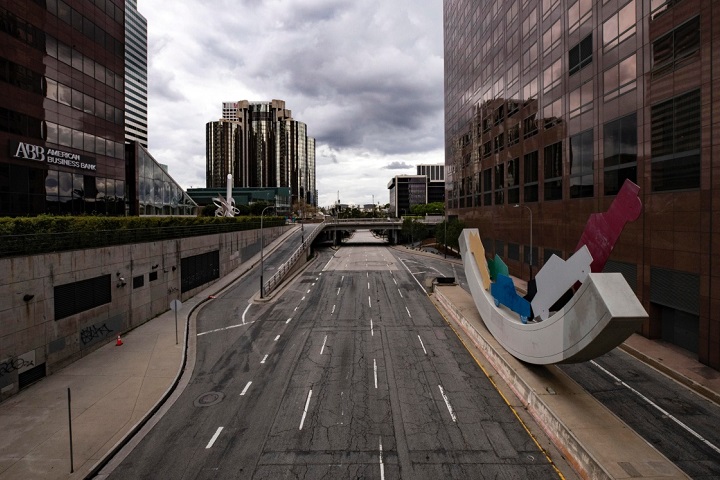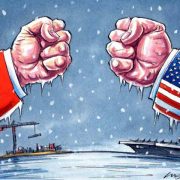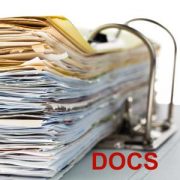
Sono italiano, vivo a Los Angeles, in California, e oggi c’è una pandemia là fuori. Vorrei poter essere più vicino alla mia famiglia e ai miei vecchi amici, ma anche se fossi in Italia adesso, non farebbe nessuna differenza.
Ci hanno chiesto di fare quello che sarebbe stato impensabile solo qualche mese fa: non andare al lavoro, non andare a scuola, non lasciare la tua casa. Il risultato è che non mi sono mai sentito così lontano e così vicino dal mio Paese allo stesso tempo.
Cronologia
È una strana sensazione di dislocazione che mi chiede un orientamento. Sento il bisogno di capire come sia giunto a questo punto, e dove sia possibile andare domani. Dunque, quello che è successo attorno a me nelle ultime settimane è questo.
25 gennaio: giorno 1. Un uomo di Orange County, una regione a sud di Los Angeles, risulta positivo al COVID-19. Si tratta del primo caso confermato nello Stato, il terzo in tutti gli Stati Uniti. Sono ancora ad una settimana dal sentire di casi confermati in Italia.
3 febbraio: giorno 10. La contea di Santa Clara dichiara l’emergenza sanitaria a causa del coronavirus; è la prima contea della California a fare una cosa del genere. La contea ha due dei sei casi riportati nello Stato, ed entrambi i casi riguardano persone che sono rientrati negli Stati Uniti da Wuhan, in Cina. La mia principale preoccupazione, in questi giorni, e sin da quando sono arrivato qui, è ancora quella di dove poter trovare un buon pezzo di parmigiano in città.
23 febbraio: giorno 30. Lunghe file di persone aspettano pazientemente fuori dal Martin B Retting, un negozio di armi a Culver City. Faccio le mie ricerche e mi accorgo che nelle ultime settimane la vendita di armi sul territorio nazionale è aumentata del 68%. Non farò mai parte di questo numero, anche se capisco la paura del virus, la possibile recessione economica di cui si sta iniziando a parlare, e il bisogno di una reazione d’urto contro le linee nemiche. Ma chi è il nemico ora? E dove sono le trincee? Chiunque è il nemico, o forse non c’è nessun amico.
4 Marzo: giorno 40. Oggi vado a fare la spesa. Lascio stare il parmigiano. Capisco che farei meglio a cercare di procurarmi le cose essenziali. Ci sono molti scaffali vuoti, la carta igienica è sparita. Google dice che i consumatori americani usa più carta igienica di chiunque altro al mondo. Persone arroganti guidano nervosamente i loro carrelli della spesa. Questo mi sembra quasi peggio della corsa alle armi. Questo è reale, sta succedendo a me, e va oltre la mia comprensione.
5 Marzo: giorno 41. Un paziente di coronavirus nella contea di Placer muore. Questa è la prima morte accertata in California, la undicesima negli Stati Uniti. In Italia ci sono tremila casi. Oggi viene deciso di chiudere tutte le scuole e le università del nostro paese.
6 Marzo: giorno 42. È il compleanno della madre di Rosanna. Rosanna è una mia studentessa, vive a Santa Monica. E nonostante il fatto che sua madre oggi compia sessant’anni, le decide di starsene a casa. Sembra terrorizzata quando mi confida che sua madre non ha capito la sua decisione, ma la capirà presto.
18 Marzo: giorno 54. Il governatore della California Gavin Newsom autorizza un aiuto di 150 milioni di dollari per i senzatetto. Il suo allarme che il 56% della popolazione, inclusi 60000 senza tetto, potrebbe essere contagiata suona come una minaccia. In Italia si registra una crescita di 5000 nuovi casi ogni giorno.
19 Marzo: giorno 55. Il governatore Newsom ordina a tutti i californiani di starsene in casa. Lo stato della California, il più popolato degli Stati Uniti (40 milioni di persone), è il primo ad emanare un ordine del genere. Ad oggi, si riportano in California 1067 casi e 19 morti.
4 Aprile: giorno 71. Mi azzardo a portare fuori Kierkegaard, il mio cane. Tom, un mio vicino, sta tagliando il prato. Tom è un giudice della Corte di appello. Dalla distanza di sicurezza, mi racconta che il Dipartimento Carcerario (quello che gestisce le prigioni di stato) sta per rilasciare 3500 detenuti per ridurre l’assembramento. La decisione, mi dice lui, è stata decisa dopo aver osservato quanto successo alle carceri italiane un mese fa, quando più di 50 detenuti sono fuggiti in libertà dopo aver protestato violentemente a causa delle restrizioni imposte per l’epidemia. Kierkegaard si godrà di più il giardino nel retro da ora in poi.
19 Aprile: giorno 86. La California riporta ad oggi 28.963 casi confermati di COVID-19, 1072 morti. L’Italia ha raggiunto questo numero di contagi il 16 Marzo, e questo numero di morti attorno il 12 Marzo, proprio prima che la curva iniziasse ad impennarsi drammaticamente. Più tardi il numero di morti giornalieri ha iniziato a sovrastare la capacità di chiamare le vittime per nome. Al contrario, la California non ha visto nessun picco, sino ad ora.
La popolazione e la politica
Forse che questa cronologia possa mostrare davvero cosa è successo? No di certo, ma mi aiuta a capire almeno due punti importanti. Innanzitutto, è chiaro che il virus in California non si è mai diffuso con un tasso di crescita incontrollato. Secondo, l’appiattimento della curva è stato il risultato di un distanziamento sociale spontaneamente adottato all’inizio di marzo, più di due settimane prima che il governatore Gavin Newsom ordinasse la quarantena per tutto lo stato. Il comportamento delle persone ha anticipato la politica.
Credo che questa cronologia mostri anche che a volte essere impauriti sia un atto di coraggio e di mutua responsabilità. Oggi, da buon cittadino, dovrei comportarmi come se fossi in preda al panico. Perché tutto ciò che facciamo ha una funzione puramente preventiva. Gioca sui grandi numeri, facendo appello a ciascun particolare. Il panico che ha afferrato i californiani è stato fondamentalmente una saggia decisione politica, messa in atto prima di tutto dal governatore dello Stato.
La ragione risiede sul fatto che oggi, in un momento storico in cui le grandi democrazie producono leadership grottesche, è ad un livello locale (fortunatamente) che le decisioni pratiche vengono prese. Ciò che è davvero spaventoso non è quello che sappiamo, ma quello che non sappiamo. Ad un livello locale, questo ignoto è più sopportabile, l’ansia è ancora sostenibile. Invece, su larga scala, la narrazione sul virus scade molto spesso in una paranoica interpretazione della storia.
Il mio amico su Facebook Mike, un millenial colto ed informato, è convinto che l’epidemia sia stata pianificata dagli “arabi”, temine che lui usa, credo, per dire i mussulmani. A proposito dell’assolutamente legittima preoccupazione globale, è però necessario non perdere il nostro senso delle proporzioni. Mi sembra che ciò che sta accadendo a livello globale, con la caotica e grottesca interpolazione di prerogative locali e nazionali, ha più il carattere del collasso della autorità pubblica, più che il tratto di una drammatica stretta totalitaria.
Lutto e trasformazione
È difficile dire di più. Nessuno conosce esattamente come l’epidemia da COVID-19 cambierà il mondo. Potremmo imparare qualcosa dando uno sguardo ad altre simili cronologie. Dalla strage di Costantinopoli alla peste nera, dalla Polio all’AIDS, le pandemie hanno violentemente trasformato le civiltà.
Mentre queste crisi provocavano vittime e lutto, hanno anche causato immense trasformazioni – in medicina, tecnologia, politica, educazione, religione, arte, e gerarchie sociali. Da questo “qui e ora”, vedo che ognuno di noi, pur senza sapere da dove viene e dove sta andando, condivide l’oscurità perché può scambiare parole, cultura, amore, avvertenze e tragedie.
È vero, siamo ora come animali immobili e rassegnati, abbagliati dai fari di una macchina. È vero che molto probabilmente la vita diventerà incapsulata e questa generale clausura causata dall’epidemia (o, meglio, dal tentativo di prevenirla) diventerà la nostra abituale forma di vita. Eppure, questa sera dovremmo concederci un po’ di riposo nella nostra condivisa solitudine con il pensiero che possiamo sopravvivere all’incertezza.
I am Italian, I live in Los Angeles, California, and today there is a pandemic out there. I wish I could be closer to my family and my old friends, but even if I were in Italy right now, it wouldn’t make any difference. We all have been asked to do what would have been unthinkable only a few months ago: don’t go to work, don’t go to school, don’t leave your house. As a result, I have never been so far away, and so close to my country at the same time. I feel that this weird perception of displacement is telling me a need of orientation. I need to understand how I got here, and where I can possibly go next.
So, this is what happened around me during the last few weeks:
January 25th: day 1. A man in Orange County, a region south of Los Angeles, tests positive for the COVID-19. It is the first confirmed case in the state, the third in the U.S. I am still one week away from hearing about confirmed cases in Italy.
February 3rd: day 10. Santa Clara County declares a local health emergency due to coronavirus, the first county in California to do so. The county has two of the now six reported cases in the state, both involving people who traveled to the US from Wuhan, China. My main concern is still, and since I arrived here three years ago, where to find a good chunk of Parmesan cheese in town.
February 23d: day 30. Long lines of customers are queueing up outside the Martin B Retting gun shop in Culver City. I do my homework and I discover that during the last few weeks gun sales nationwide increased 68%. I hate guns, I will never be part of this number, even if I understand the fear of the virus, the possible economic recession they are beginning to announce, and the need of a shock reaction to break the enemy line. But who is the enemy this time? And where is the line? Anybody is the enemy, or maybe there is no enemy at all.
March 4th: day 40. Today, I go shopping. Forget about the parmesan. I should better focus on essential goods. Lots of empty shelves, toilet paper has vanished. Google says that U.S. consumers use more toilet paper than anyone else in the world. Pushy people drive their carts around very nervously. It looks worse than the arms race I read about. This is real, this is happening to me, and it is beyond my comprehension.
March 5th: day 41. A coronavirus patient in Placer County dies, the first death related to the virus in California and the 11th in the country. In Italy there are 3000 cases confirmed. Today, Italy decides to close all schools and universities.
March 6th: day 42. It is Roseanne’s mother birthday. Roseanne is a student of mine, she lives in Santa Monica. And despite the fact her mother today turns 60, she decides to stay home. She looks terrorized when she tells me that her mother doesn’t understand her decision, but she will.
March 18th: day 54. Gov. Gavin Newsom of California authorizes $150 million to aid the homeless. He warns that 56% of the population, including more than 60,000 homeless, could get the virus in the next eight weeks. In Italy, they are growing with a rate of 5000 new cases every day.
March 19th: day 55. Gov. Newsom has ordered Californians to stay at home. California, America’s most populous state (40 million), was the first to order all residents to stay home. As of today, in California there are 1067 reported cases, and 19 deaths.
April 4th: day 71. I dare to walk Kierkegaard, my dog. Tom, my neighbor, is cutting the grass. Tom is a judge for the Appeal Court. From a safe distance, he tells me that the California Department of Corrections (which runs the state prisons) is planning to release 3,500 inmates to reduce crowding. The decision was taken, he told me, after having seen what in Italy happened a month ago, when more than 50 inmates were on the loose amid prison riots caused by restrictions imposed for the epidemic. Kierkegaard will enjoy the back yard from now on.
April 14th: day 81. California has reported 23,542 confirmed cases of COVID-19 and 683 deaths. Italy reached this number of cases on March 16th, and this number of deaths around March 12th, just before its curve started to spike dramatically. Later, the Italian death rate started to overwhelm the capability to name the victims. On the contrary, California is not seeing any surge, so far.
Does this timeline show what really happened? Obviously not, but it helps me to understand at least two useful points. First, the virus in California has not been spreading at an uncontrolled rate. Second, much of the flattening achieved was the result of social distancing spontaneously adopted at the beginning of March, more than two weeks before Gov. Gavin Newsom’s statewide stay-at-home order was issued. People’s behavior anticipated politics.
I think this timeline also shows that sometimes being frightened is an act of courage and mutual responsibility. Today, as a good citizen, I should behave as if I were panic-stricken. Because everything that’s being done has a purely preventive function. It plays on large numbers but appeals to each individual. The panic that has stricken Californians was basically a wise political choice, established first and foremost by the State Governor. Because today, in an era when the great democracies are producing grotesque leaderships, it’s on a local level that (fortunately) the real decisions are taken.
What is really frightening is not what we know, but what we do not know. On a local level, this unknown is more bearable, the anxiety is still sustainable. However, on the large scale, the narrative about the virus falls very often into a paranoiac interpretation of history.
My Facebook “friend” Mike, a very well-educated millennial, is convinced that the epidemic was schemed by the “Arabs”, by which I suppose he means the Muslims. Regarding absolutely legitimate global concerns, it is necessary not to lose our sense of proportion though. It seems to me that what is happening on a global level, with the chaotic and rather grotesque overlapping of national and local prerogatives, has more the character of a breakdown of public authority than that of a dramatic totalitarian grip.
It is hard to say more than this. No one can know exactly how the COVID-19 pandemic will ultimately change the world. We might learn something by taking a look at other similar timelines. From the Plague of Justinian and the Black Death to polio and AIDS, pandemics have violently reshaped civilization.
While the outbreaks wrought their death tolls and grief, they also prompted massive transformations — in medicine, technology, government, education, religion, arts, and social hierarchy. From this “here and now”, I see that each one of us, without knowing the whence and whither of it, share the obscure because we can share words, cultures, love, cautions and tragedies.
It is true, we are all now immobile and resigned like animals who are caught in the headlights. It is true that most probably, life will become incapsulated, and this generalized seclusion caused by the epidemic (or rather, by attempts to prevent it) will become our habitual way of life. And yet, tonight we should rest a while in our shared solitude with the thought that we can survive the incertitudeness.





